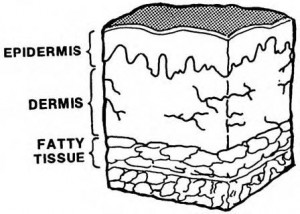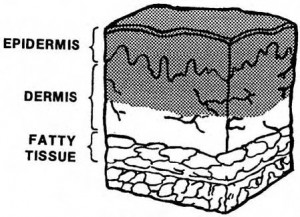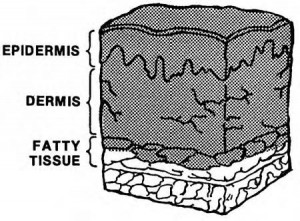The true depth of a thermal burn injury can be determined with certainty only by examining the tissue.
During resuscitation of the patient, the primary concern is the total percentage of skin surface involved in second-degree and third-degree burns.
Later, this information will be useful in determining treatment; for example, whether or not there is a need for skin grafts to close the wound. However, you are initially concerned with the amount of skin surface burned. Most thermal burns are a combination of first-degree, second-degree, and third-degree burns.
a. First-Degree Burn (Mild Partial Thickness Burn).
A first-degree burn (figure 3-1) is a superficial injury involving only the outer layer of skin, the epidermis.
A common example of first-degree burn is sunburn. As in sunburn, a first-degree burn is very painful. Typical characteristics are reddened skin which is dry and warm to the touch without blisters. These burns usually heal on their own in two to five days without scars. The outer layers may peel. The name “partial thickness” comes from the fact that the burn extends only partially through the epidermis, the first skin layer.
Usually, first-degree burns are not included in an estimate of the total body surface area (TBSA) burned. The reason is that these burns cause no loss of skin function even though a person with first-degree burns may feel ill and have a body temperature a little above normal. (The exception is that the TBSA of first-degree burns is important when the severity of the burn is being determined. See paragraphs 3-11f, 3-12c, and 3-13c.)

b. Second-Degree Burn (Partial Thickness Burn).
Second-degree burns (figure 3-2) extend into, but not through, the second layer of skin (the dermis), giving these burns the name “partial thickness.”
The color of the burn varies depending upon its depth. Deep burns may be dark or pale and colorless. Burns of less depth may be pink or red and blotchy. The sensitivity of these burns also varies, depending on the depth of the burn. A superficial second-degree burn can be very painful and sensitive to touch and air movement. A deeper second-degree burn can have normal or decreased sensation to touch.
A second-degree burn that is very deep may be hard to distinguish
from a third-degree burn and may have no sensation. The most common condition is that the burn is very painful. Slight pressure or air movement causes intense pain. Swelling and blistering occur for about 48 hours after the injury. Usually, second-degree burns heal in 14 to 30 days, frequently without scarring.

c. Third-Degree Burn (Full Thickness Burn).
Third-degree burns (figure 3-3) are also known as full-thickness burns because they involve the full thickness of the epidermis and the dermis.
The burns may look yellow-brown, dark red, charred, or white and translucent. Those with red-colored areas will not blanch. The nerves in the deeper layers of the dermis have been destroyed; therefore, unlike the first- and second-degree burns, there is no pain or sensation in the burned areas. The skin is dry, firm, and leathery. The burn has caused the skin to lose its normal elasticity, thus
restricting movement. A third-degree burn on a large part of the chest wall can limit lung expansion. A third-degree burn around an arm or a leg can constrict blood flow.
These burns usually heal with scars or require skin grafts to heal. Unless the body surface burned is small, a third-degree casualty requires hospitalization.

NOTE: A burn that involves muscle or bone as well as subcutaneous tissue is sometimes classified as fourth-degree burn. Electrical burns can damage muscle or bone as the current travels through the body.
NOTE: Those areas of thermal injury that are waxy-white, soft and pliable, yet nonpainful formerly were regarded as full-thickness injuries, but are really deep partial-thickness burns. They frequently heal without the need for grafting if protected from infection. Charring with thermal injury of subcutaneous and deeper tissues is infrequent, but may occur in an unconscious victim, in individuals sustaining high voltage electric injury, in persons trapped by burning debris, or in occupants of a burning vehicle.
